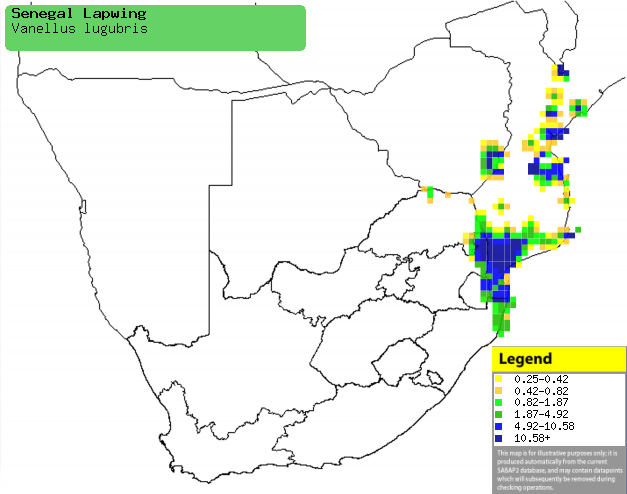|
Vanellus lugubris (Senegal
lapwing, Lesser black-winged plover)
Kleinswartvlerkkiewiet [Afrikaans]; iTitihoye (also
applied to Crowned lapwing) [Zulu]; Ghelekela (generic term for plover)
[Tsonga]; Rouwkievit [Dutch]; Vanneau terne [French]; Trauerkiebitz [German];
Abibe-d'asa-negra-pequeno [Portuguese]
Life
> Eukaryotes >
Opisthokonta
> Metazoa (animals) >
Bilateria >
Deuterostomia > Chordata >
Craniata > Vertebrata (vertebrates) > Gnathostomata (jawed
vertebrates) > Teleostomi (teleost fish) > Osteichthyes (bony fish) > Class:
Sarcopterygii (lobe-finned
fish) > Stegocephalia (terrestrial
vertebrates) > Tetrapoda
(four-legged vertebrates) > Reptiliomorpha > Amniota >
Reptilia (reptiles) >
Romeriida > Diapsida > Archosauromorpha > Archosauria >
Dinosauria
(dinosaurs) > Saurischia > Theropoda (bipedal predatory dinosaurs) >
Coelurosauria > Maniraptora > Aves
(birds) > Order: Charadriiformes
> Family: Charadriidae > Genus: Vanellus
Distribution and habitat
Occurs discontinuously from Senegal through the DRC to
Uganda, Kenya, Tanzania and Malawi to southern Africa. In southern Africa it is generally
scarce in Mozambique, south-eastern Zimbabwe and north-eastern South Africa. It
generally prefers dry, open plains with patches of bare ground and short
grass, as well as savanna, open woodland, bare fields, heavily grazed grassland,
airfields and pan edges.
|
 |
|
Distribution of Senegal lapwing in southern Africa,
based on statistical smoothing of the records from first SA Bird Atlas
Project (©
Animal Demography unit, University of
Cape Town; smoothing by Birgit Erni and Francesca Little). Colours range
from dark blue (most common) through to yellow (least common).
See here for the latest distribution
from the SABAP2. |
Predators and parasites
Movements and migrations
Its movements in southern Africa are not well
understood, as it is mainly resident in Zimbabwe but is a regular
non-breeding summer visitor to the Kruger National Park, while it is
a breeding winter visitor to northern KwaZulu-Natal. It departs from
KwaZulu-Natal in
the period from December-January, probably heading to Mozambique
and the South-African lowveld.
Food
It mainly eats termites, supplemented other terrestrial
invertebrates, doing most of its foraging visually, plucking from the ground by
day and night. It often forages along with other birds, such as
Crowned,
Blacksmith and African wattled lapwings,
Kittlitz's and
Caspian plovers,
Ruff,
Temminck's courser,
Red-crested korhaan,
egrets,
ibises,
starlings,
barbets, longclaws,
pipits and
larks. The following food items have been recorded
in its diet:
- Invertebrates
- Small grass seeds
Breeding
- Monogamous, usually loosely colonial nester, with the male defending a
small territory by calling from an elevated mound and chasing intruders
away.
- Egg-laying season is from June-December, peaking from August-December.
- It lays 3-4 eggs, which are incubated by both sexes for about 27-28 days, in
shifts of roughly 40 minutes (longer in colder weather).
- The chicks leave the nest after about four hours, once their down is
dry; the adults take turns in caring for the chicks and directing them to
food items, so that the parent not on duty can feed. If a predator
approaches the parent on guard performs a distraction display while the
chicks find somewhere to hide. They eventually fledge at about 29-31 days
old, sometimes only becoming fully independent at the onset of the following
breeding season, a year later.
Threats
Rare in South Africa, so is susceptible to regional
extinction, although not threatened globally.
References
-
Hockey PAR, Dean WRJ and Ryan PG 2005. Roberts
- Birds of southern Africa, VIIth ed. The Trustees of the John Voelcker
Bird Book Fund, Cape Town.
|
